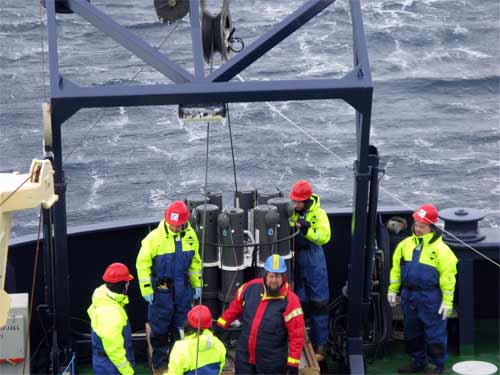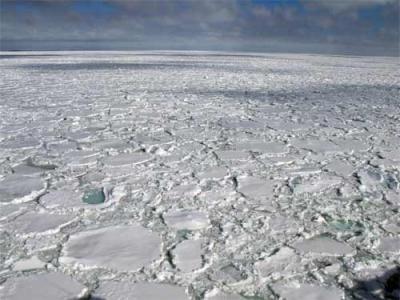Latitude: 68? S Longitude: 91.37W Temperature: **-2.5 degrees C **Wind Chill: -23.3 degrees C
The day started out with possibly the best night's sleep so far for everyone. Being in the ice has slowed the ship to a much smoother ride. The first thing I did upon waking was to look out the window. What a surrealistic scene! Thick clouds covered the sky and there was ice and snow all around us. I was told we were entering the area where the scenery really changes and we will begin to see icebergs. I was not disappointed! The biggest problem is trying to figure out which direction to look at- it all looks great! A fellow shipmate told me by the end of the trip I will be tired of the ice. I DON'T THINK SO.
Hershey Kiss Iceberg
 This reminds me of a Hershey Kiss!*
This reminds me of a Hershey Kiss!*
The science work began at 8AM. The Oden stopped to allow the conventional CTD to be cast. Everyone on the CTD crew bundled up and met on the work station on the bow of the ship. The weather was icy and cold. The CTD was lowered into the water as members of the science team waited for the first collection of sea water samples. But, as life often goes, there was a problem. An electronic problem prevented data reception. So a decision was made to cast the Trace Metal CTD instead. A CTD measures conductivity, temperature, and depth. A Trace Metal CTD does the same thing, but it has no metal parts allowing a 'clean' sample of water to be collected. Chief Scientist Rob Sherrell's project depends on the TMCTD. Rob, Associate Professor at Rutgers University, is studying the interaction between phytoplankton and trace metals dissolved in seawater. Typical phytoplankton contain many metals, iron being the most abundant on average. The Southern Ocean is thought to have a sufficient supply of all the metals required by phytoplankton except iron. But there is SOME iron supplied to the waters of the Southern Ocean, or the cells wouldn't grow at all. So where does it come from? The TMCTD provides a 'clean' sample of seawater that will give him information about the concentrations of nutrient metals that are dissolved and available for uptake by the phytoplankton cells. Samples taken at different locations will, he hopes, point to the iron source. Rob will also filter the phytoplankton out the water and try to determine how much of each metal is inside versus outside of living phytoplankton cells. His samples will be sent to the Rutgers Inorganic Analytical Lab, of which he is faculty director, for analysis.
Trace Metal CTD team
 Getting the TMCTD ready to launch. People standing around the CTD rosette.*
Getting the TMCTD ready to launch. People standing around the CTD rosette.*
Ice before Oden Passes
 This is the ice field before the Oden cuts through.*
This is the ice field before the Oden cuts through.*
Oden Street
 This is the ice field after we pass - Oden Street!*
This is the ice field after we pass - Oden Street!*
First Seal
 Can you spot the seal in this photo?
Can you spot the seal in this photo?
Mountain berg
 It doesn't look real does it?? *
It doesn't look real does it?? *

